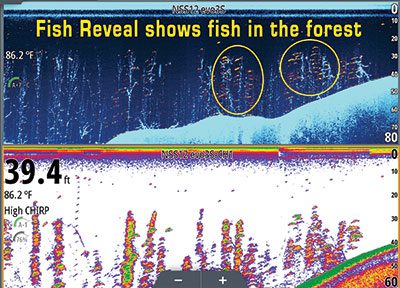
NutsAndBoltsFishing.com
There are numerous man-made lakes throughout the country that were created as water reservoirs for power generation or erosion control. Many of them were dammed up as far back at the 1930’s. When most were built, they left the standing timber intact, cutting off the tops when the lake was around 20 to 30 feet below full pool. Georgia’s Lake Lanier, Clarks Hill, Hartwell, and others are good examples. This timber, far below the water line, has essentially been ‘petrified’ in the dark, cold, low-oxygen content water, and serves as cover for baitfish, and ambush points for game fish.
In the warm weather months, the surface water temperature rises and the thermocline sets up, providing a relatively narrow layer of the water column where there’s enough oxygen for active game fish to be comfortable. On bright sunny days, the fish we’re targeting will go deeper as the sun comes up. Where do they go? Right into the treetops. Simrad’s DownScan paints a remarkable image of the trees below, and with Fish Reveal turned on, you can see stripers, hybrids, bass and even crappie cruising in and just above the trees.
Game fish feeding times are based on a variety of factors; the sun and moon, water temperature, amount of light and, of course, the proximity of bait, to name just a few. Even when they are not on their normal feeding schedule, you can still elicit a reaction strike. So just because you see them appearing to take a siesta in the trees, it doesn’t mean those fish are not ‘catchable’.
For anglers, fishing the trees does present a number of challenges. The first one is locating them. Sometimes tree limbs will mark as fish on your sonar. So having your machine adjusted correctly is paramount. Having a sonar unit with DownScan and SideScan that can discern fish from other ‘stuff’ down there is critical. Simrad’s Fish Reveal combines traditional sonar, which makes fish appear as arches, with their high resolution DownScan Imaging, so fish will show up as arches amidst all the other objects DownScan is revealing. It’s really cool technology.
The next challenge is getting these semi-lethargic fish to bite. For me, that strategy comes in two forms: live bait and jigging spoons. Jigging spoons will definitely trigger a reaction strike. The big Parker spoons are among my favorite, but diamond jigs will work and so will larger Clark spoons. This is a great search technique because you can cover a lot of ground quickly. You can watch the jig drop on the Simrad and start retrieving just as it makes the tops of the trees. Dropping into the trees is risky. Those petrified limbs do not easily give up a fouled spoon.
When tree-fishing, I think the best tactic is live bait. Again, you have to be keenly aware of the treeline depth. If you drop your bait down too deep, when a fish hits it, there’s a strong likelihood the fish will run back for the cover and get tangled in the limbs. No one wins this game. You’ll wind up breaking your leader, and the fish will stay hung up, probably dying. So, when deploying your rigs, make sure your baits are positioned just above the trees. I typically use about 4 feet of fluorocarbon leader below the 1 ½ ounce sinker. If the treetops are 25 feet below the surface, I’ll position my sinker around 18 feet. This gives the bait plenty of room to swim around without getting tangled in the branches, and if a big fish hits and pulls drag, you have a good chance at getting him turned before he can make it back to the forest.
So now you’re saying, “If the fish are down around 30 to 35 feet in the trees, how can I expect them to come up to 20 feet and eat?” Believe me, it happens all the time. Remember that Mother Nature built most game fish to feed “up”. On a clear, sunny day those baits present a tasty silhouette that will generate a reaction strike, and oftentimes will cause the entire school to come out to play.
This is true for more than just stripers and hybrids. We’ve pulled catfish off a 50 foot bottom to come up and eat baits at 25 feet. Spotted bass and smallmouth sitting on a ledge will gladly make the 20 to 30 foot ascension to eat a tasty morsel. One key I’ve found is that it’s best to put out a pretty good spread of baits. I’ll drop at least four downlines over the side, and many times, I’ll do six. When all the rods start bending, it’s cockpit chaos, and it’s a lot of fun!
So when the sun comes up and the fish go down deep, change your strategy to fish the forests and you’ll put more fish in the boat. Tight lines and calm seas.